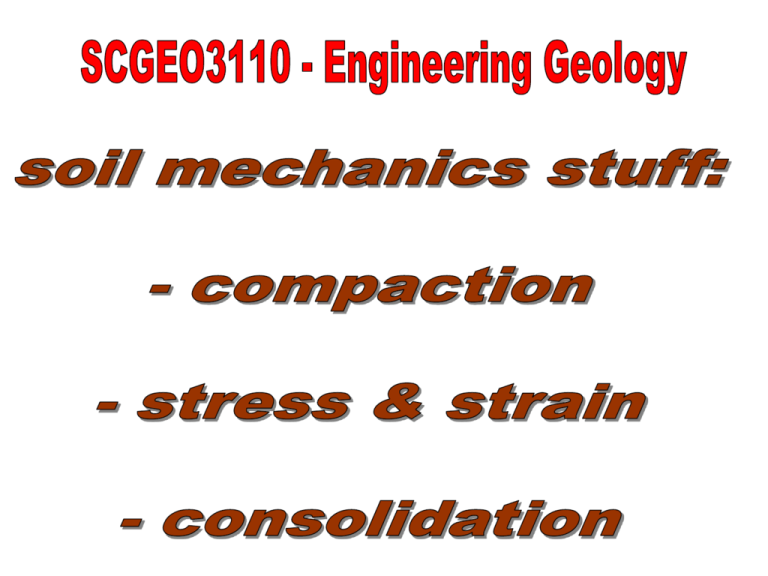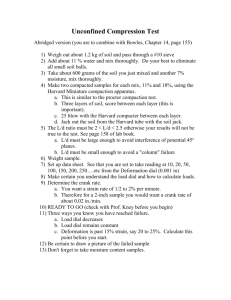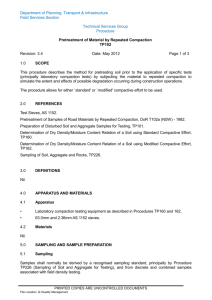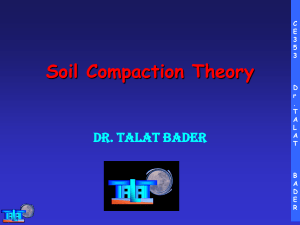Compaction_stress_consol
advertisement

What is compaction? A simple ground improvement technique, where the soil is densified through external compactive effort. Compactive effort + water = Why compact soils? Increases strength Decreases permeability Reduces settlement Reduces shrinkage Applications: Roads Foundations Embankments Dams Aircraft runways Parking areas Paving Retaining walls Rammed earth structures Etc. etc. Theory: Ralph R. Proctor (circa 1933) related compaction to four variables: Dry density Moisture content Compactive effort Soil type Laboratory tests Mould (standard dimensions) Hammer (standard cross-section area, weight, drop) Method (standard number of layers and number of drops for each layer) Mositure content Dry density (d) Compaction Curve Soil grains densely packed - good strength and stiffness - low permeability d, max optimum water content Water content Compaction Curve Dry density (d) What happens to the relative quantities of the three phases with addition of water? air water soil difficult to expel all air lowest void ratio and highest dry density at optimum w Water content Dry density (d) Zero Air Void Curve - corresponds to 100% saturation Zero air void curve (S=100%) S<100% Gs w Eq : d 1 wGs S>100% (impossible) All compaction points should lie to the left of ZAV curve Water content Dry density (d) Effect of Compactive Effort E2 (>E1) Increasing compactive effort results in: • Lower optimum water content • Higher maximum dry density E1 Water content more dispersed fabric Dry density (d) Compaction and Clay Fabric Higher water content or higher compactive effort gives more dispersed fabric. more dispersed fabric Water content Dry density (d) Line of Optimum Compaction curves for different efforts Line of optimum Water content Laboratory Compaction Test - to obtain the compaction curve and define the optimum water content and maximum dry density for a specific compactive effort. Standard Proctor: hammer Modified Proctor: • 3 layers • 5 layers • 25 blows per layer • 25 blows per layer • 2.7 kg hammer • 4.9 kg hammer • 300 mm drop • 450 mm drop 1000 ml compaction mould Compaction Control -a systematic exercise where you check at regular intervals whether the compaction was done to specifications. e.g., 1 test per 1000 m3 of compacted soil • Minimum dry density • Range of water content Field measurements (of d) obtained using • sand cone • nuclear density meter simple stress (Axial stress) Stress (Pascal) = Force (Newton) Area (square metre) Mass x gravity Area Reaction force Soil mechanics: stress Stress due to the weight of soil above s =gh v s2 s3 sv = vertical stress (kPa) Stress ellipsiod s3 Horizontal stresses s2 g = unit weight of soil (kN/m3) h = depth (m) Soil mechanics: stress Stress due to the weight of soil above s =gh v s3 sv = vertical stress (kPa) s2 g = unit weight of soil (kN/m3) h = depth (m) s2 s3 Horizontal stresses Soil mechanics: stress & strain Circular failure surface due to shearing of the soil Barham River valley Apollo Bay 1987 Moorabool River valley Gheringhap 2001 shear stress Normal stress (s) Shear stress (t) Charles-Augustin de Coulomb 1736 - 1806 Coulomb Equation t = c + s tanf t = shear stress c = cohesion s = normal stress f = angle of shearing resistance shear stress The groundwater in the pore spaces creates an uplift pressure – the pore water pressure – to the shear plane. The pore water pressure relates to the pressure head caused by the weight of water and rock above Water table The normal stress (s )is countered by the pore water pressure (u) and the result (s – u) is called the effective stress (s’) Mohr - Coulomb Equation t = c’ + s’ tanf’ s u t = shear stress c’ = effective cohesion s’ = effective stress f’ = effective angle of shearing resistance Slope mechanics: rainfall as a trigger of instability Raising the watertable increases the pore-water pressure and reduces the effective stress, which in turn lowers the soil’s shear strength and causes a shear failure Pore water pressure Water table Rainfall event time Soil mechanics: stress Stress due to the weight of soil above s =gh v s2 s3 sv = vertical stress (kPa) g = unit weight of soil (kN/m3) h = distance (m) Stress ellipsiod s3 Horizontal stresses s2 Soil mechanics: strain Strain is the change in shape caused by the application of stress Kinds of strain Strain ellipsoid Oblate (s1 > s2 = s3) Prolate (s1 = s2 > s3) Triaxial (s1 > s2 > s3) Introduction to Consolidation When a saturated clay is loaded externally, GL saturated clay the water is squeezed out of the clay over a long time (due to low permeability of the clay). Soil Consolidation settlement This leads to settlements occurring over a long time, time which could be several years. In granular soils… settlement Granular soils are freely drained, and thus the settlement is instantaneous. time Laboratory testing consolidation








